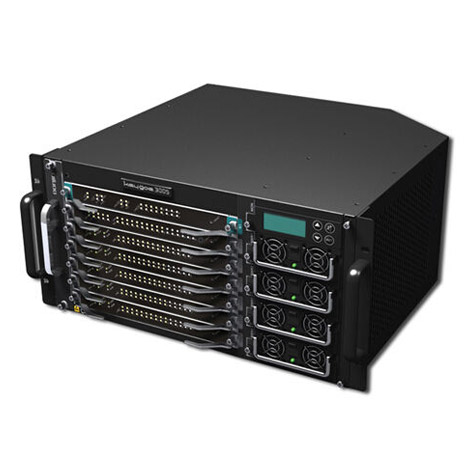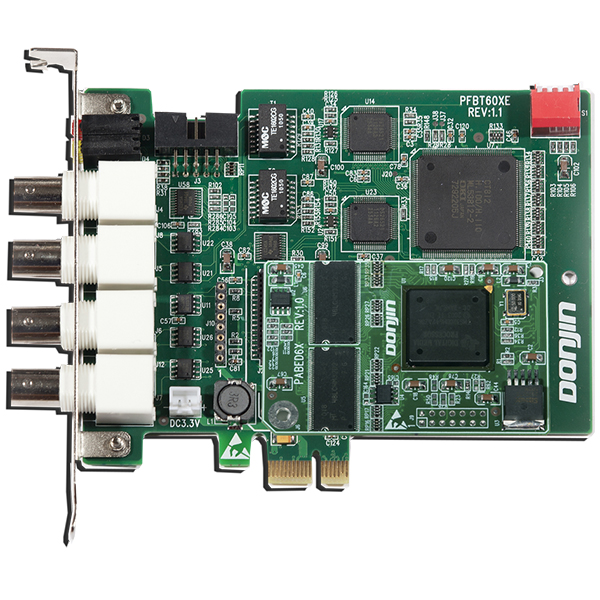K320-E, K320-E/RJ48
DONJIN Keygoe200 digital interface processing boards adopt PCIe computer bus structure, and one board could provide 1E1/2E1 digital trunk interfaces, and two kinds of physical interfaces BNC and RJ48. Using DONJIN Keygoe SDK, It can be used for voice playing/recording, conferencing, faxing, VoIP, ISDN PRI, SS7, FSK data receiving/sending, text to speech (TTS), and many other functions. They can also be used with Keygoe200 analog interface processing board K161A-E. Besides, using the echo suppression processing circuits, the boards have quite excellent voice quality.
l Use advanced Keygoe multimedia processing technology, and inherit the openness and flexibility of the Keygoe series products;
l Be compatible with Keygoe EasyAPI; without any modificaiton, the applciation could be used in all Keygoe series products;
l One board could perform the multimedia processing functions such as the voice, conference, fax, VoIP, and SS7, not requiring to configure any resource board;
l Use echo suppression processing at the interface, and provide the posibility to improve the IP application performance;
l The small size is suitable for space-limited server, PC, or IPC.
? Voice interface
l Adopt special echo suppression processing circuit, and provide a maximum of 128 ms echo suppression processing capability;
l Support the continuous speech processing (CSP), voice interrupt, and the real-time voice playing/recording of memory and file server;
l Support the mix voice playing/recording and voice recording/playing in a full duplex mode;
l Support the conversion between the A law and μ law;
l Possess the function of caller identity detection (CID); support two CID modes: DTMF and FSK;
l Support the DTMF, FSK, and customized envelope tone generation and detection;
l Support to adjust the DTMF receiving/sending sensitivity; adapt to different lines or terminals;
l Support the automatic gain control (AGC/ALS);
l Support the voice activity detection (VAD) and comfort noise generation (CNG);
l Support the DPD and PVD.
? Fax
l Support to receive/send the .tiff files;
l The supported maximum fax receiving/sending speed rate is up to 14400 bps, and the automatic down-speeding is supported to adapt to various communication environments;
l Support the fax receiving/sending in an ECM mode; during the handshake, the ECM/NON-ECM mode is selected by self-adaptation;
l Support to receive/send a single or multiple fax pages, and the sent/received page count is not limited;
l Support to send multiple files once;
l Support to add customized page headers by function invoking.
? IP
l Support the H.323 protocol group, and could connect to the IP telephone gateway, gatekeeper, and soft switch which also support the H.323;
l Support the SIP, and could connect to the function servers that also support the SIP;
l Support encoding/decoding standards, including G.711, G.723.1, G.729A, and so on;
l Support the voice active detection (VAD) and silence compression.
? Conference
l Detect the DTMF tones generated by any conference member, and shield the tones to other members;
l The automatic gain control (AGC) ensures each conference member has the same volume;
l Personal volume control ensures each member can adjust the volume to a satisfied level.
? Signaling
l Support China SS1;
l Support the DSS1 (ISDN PRI);
l Support the ITU-T SS7 and China SS7; support the MTP, TUP, ISUP, and SCCP (transparency); suppor the point codes of 14 bits and 24 bits.
l Interface number: 1E1;
l Maximum board nubmer in one computer: 2;
l Size: 142 mm * 100 mm;
l Maximum voice resources in one computer: 128 channels;
l Maximum fax resources in one computer: 16 channels;
l Maximum VoIP resources in one computer: 64 channels;
l Maximum conference resources in one computer: 64;
l Maximum SS7 resources in one computer: 8 channels (64 kbps);
l Computer bus: PCIe;
l Operating system: Microsoft Windows XP/2003/2008;
Red Hat Enterprise Linux 5/6, CentOS 5, Debian 6, Ubuntu 11 Server.
1. Voice resources:
l physical interface: conform to the G.703, and support the coaxial cable (75 Ω unbalanced), twisted-pair cable (120 Ω balanced);
l Frame structure: conform to the frame structure of G.704 and multiframe alignment of G.706;
l The 2048 kbps PCM confirms to the G.732 and G.796;
l The alarm conforms to the G.775;
l The jitter and wander conforms to the G.823;
l Voice encoding format: G.711 (support A law/μ law PCM, AMI-ADPCM), G729, G723.1, and so on;
l Voice file format: WAVE, PCM, ADPCM, VOX, and so on.
2. Fax resource
l Support the T.30;
l Support to receive/send the fax confirming to the V17/V29/V27 standards at a rate of 14400/9600/7200/4800/2400 bps;
l Support to receive/send the fax in an ECM mode; during the handshake, the ECM/NON-ECM mode can be selected by self-adaptation;
l Support to receive/send the .tiff file in the MH, MR, and MMR formats.
3. VoIP resource
(1) RTP
l RTP/RTCP (RFC3551/3552);
l Voice packet sampling length/frame number can be configured (10–60 ms);
l RTP dynamic DTMF load (RFC2833/4733);
l Jitter buffer: Support the static jitter mode and dynamic self-adaptation mode simultaneously;
l Analyze the network environment and make the statistics of packet loss;
l NAT/firewall detection and traversal.
(2) H.323
l ITU-T H.323v2 (H.225v2/H.245v3);
l Call parameters such as the Fast Start, and H.245 Tunneling;
l Call forwarding;
l Gatekeeper auto discovery and login (Support the number registration types of H.323 UID and E164);
l H.245 user input character and DTMF signal message (User Input Indication);
l Terminal registration management.
(3) SIP
l IETF SIPv2 standard (RFC3261);
l UDP/TCP call mode;
l MD5(digest) authentication;
l REFER call forwarding (RFC3515);
l SIP (RFC3265 SUBSCRIBE/NOTIFY);
l Proxy server registration, security authentification, and regular refreshing;
l SIP INFO message(RFC2976);
l Registrar; support the authentication of the service part;
l NAT/firewall detection and traversal.
4. SS7
l Conform to the ITU-T signaling system No.7, including the Q.700-Q.716, Q.721-Q.766, and Q.771-Q.795;
l Maximum message processing ability for each link: 500 MSU/S;
l Support the MTP, TUP, ISUP, and SCCP (transparency);
l Support the 64 kbps standard link;
l Support the 14/24-bit point codes;
l Support the traffic balancing between the links and link groups;
l Support the link switch and switch back in a link group;
l Support multiple OPCs (originating point codes) and DPCs(destination point codes);
l Support to dynamically add, delete, activate, recover, deactivate, normally restart, urgently restart signaling and to process signaling congestion;
l Support the SP and STP function.
l Call center of small to medium sized enterprise (including IP call center);
l Telephone exchange of small to medium sized enterprise (including IP PBX);
l Industry IVR;
l Telephone conference system in enterprise level;
l Network fax system in enterprise level;
l Enterprise telephone recording system;
l Dispatching and emergency commanding system;
l …
DONJIN Keygoe200 digital interface multimedia processign board is applied in the medium-sized IP call center.

Solution features:
l Use two K320-E boards or one K640-E board, and use with two K161A-E boards together; provide a maximum of 2 E1 digital interface trunk access and 32 analog agents;
l Support the digital trunk access using the SS7;
l The functions of recording, faxing, IP agent, and conferencing can be performed without configuring any media resource board;
l Adopt special echo surpression circuits for exellent call quality;
l One computer could provide a maximum of 64 IP agents;
l One computer could provide a maximum of 16 fax resources;
l The cost-efficient feature meets the requirment of growth-type enterprise.
Name | Type | Image | Function | |
Software | Fax resource software | SXFAX-K2 | It provides 4 fax resources; support the T.30. | |
VoIP resource software | SXVOIP-K2 | It provides 4 VoIP resources; support the SIP and H.323. | ||
SS7 resource software | SXSS7-K2 | It provides one SS7 resource; support the MTP, TUP, ISUP, and SCCP (transparency). | ||

 “Financial Product”WeChat
“Financial Product”WeChat “Telecommunication Product”WeChat
“Telecommunication Product”WeChat









 Download
Download